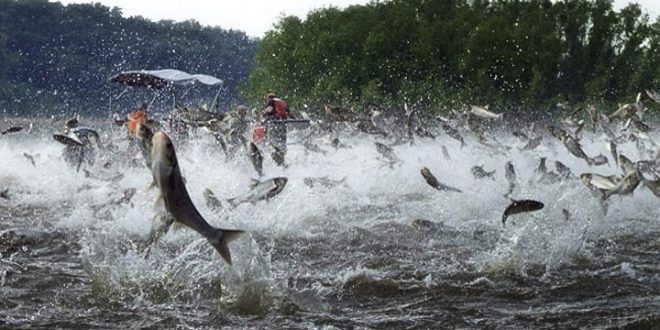The researchers from the University of Illinois and U.S. Geological Survey have discovered that the hostile carps that threaten the Great Lakes basin respond strongly to carbon dioxide.
Bighead carp and silver carp are species of invasive Asian carp that threaten the Great Lakes. Researchers with the University of Illinois and U.S. Geological Survey tested the effectiveness of infusing water with recycled CO2 gas to discourage the movement of bighead and silver carp. Both carp species avoided CO2-infused water in a research pond at the USGS Upper Midwest Environmental Sciences Center in La Crosse, Wisconsin.
“These fish responses provide evidence that CO2 could be used as a tool to deter the movement of bighead and silver carp,” said Michael Donaldson, a University of Illinois researcher and the study’s lead author. “The results are encouraging because there is a need for additional methods to prevent the entry of Asian carp into the Great Lakes.”
The scientists gradually added light plumes of CO2 gas throughout the USGS test pond. They monitored the behavior of individual bighead and silver carp, as well as the behavior of native fish species such as bigmouth buffalo, channel catfish, paddlefish and yellow perch, before, during and after the addition of CO2. The scientists found that:
- Each fish species except for paddlefish avoided the areas of the pond with CO2-infused water;
- Certain bighead and silver carp movements slowed down immediately after CO2 was injected; and
- Bighead carp used a smaller area of the pond furthest from the injection sites immediately after CO2 was added.
“Further tests are needed before CO2 can be used in Asian carp management,” said Jon Amberg, a USGS scientist and coauthor of the study. “Understanding the effects of long-term, elevated CO2 exposure on fish and other organisms can help assess its risks to native organisms.”
The next research step is to test the usefulness of CO2 gas in controlling bigheaded carp movement in a natural river.
Non-native Asian carp can damage ecosystems in the Great Lakes basin by competing with native fish and mussels for food. Large silver carp are also hazardous to boaters because they can leap up to 10 feet out of the water when startled.
Agencies/Canadajournal

 Canada Journal – News of the World Articles and videos to bring you the biggest Canadian news stories from across the country every day
Canada Journal – News of the World Articles and videos to bring you the biggest Canadian news stories from across the country every day

